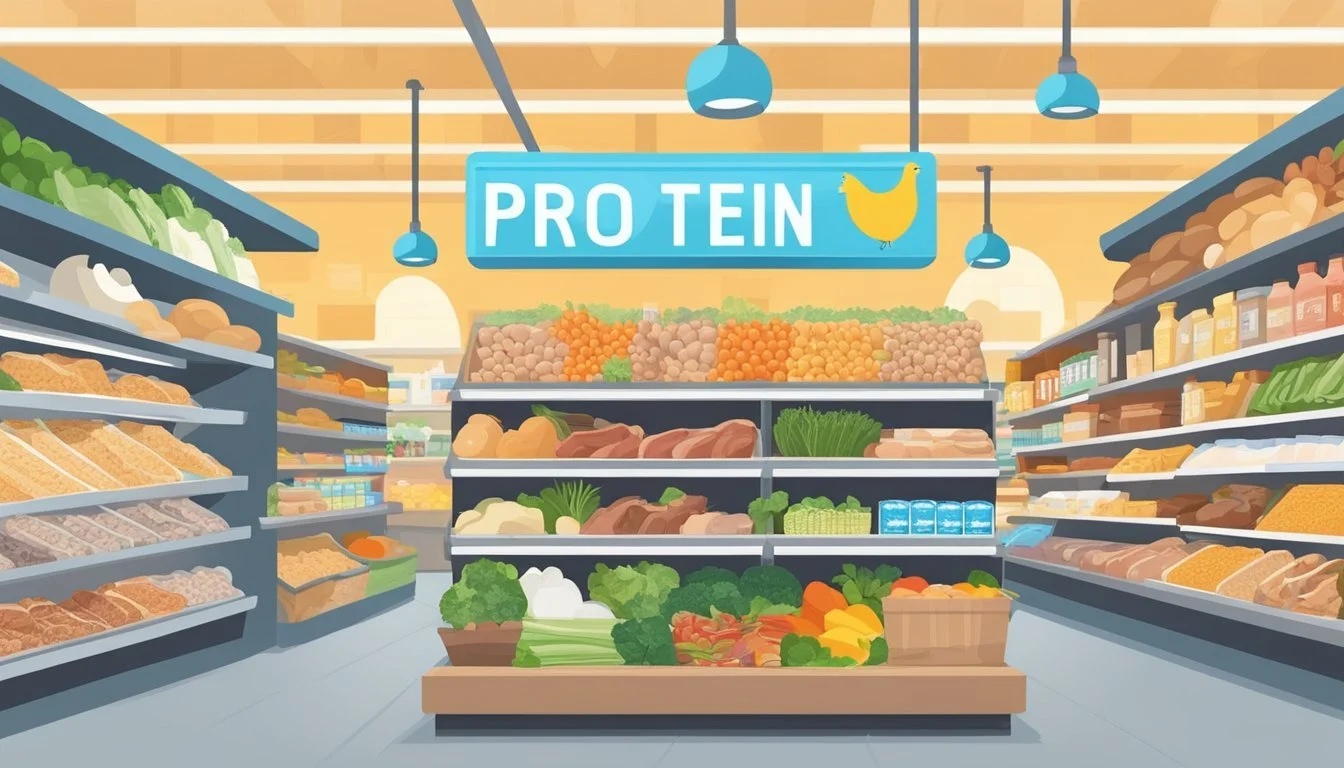Muscle-Building Meccas: Unveiling the Top Grocery Stores for Protein-Packed Shopping
Protein is a crucial macronutrient for building muscle, maintaining a healthy weight, and supporting overall wellness. Finding the right grocery store with a wide selection of high-quality protein sources can make meal planning and healthy eating much easier.
The best grocery stores for protein typically include large chains like Costco, Whole Foods, and Sprouts Farmers Market, which offer extensive selections of both animal and plant-based protein options. These stores stock everything from lean meats and fish to dairy products, eggs, legumes, and protein-packed snacks.
Costco stands out for its bulk protein offerings, including large packs of eggs, meats, and protein powders at competitive prices. Whole Foods and Sprouts excel in providing organic and specialty protein options, such as grass-fed meats, wild-caught fish, and plant-based alternatives. These stores also offer convenient pre-cooked options like rotisserie chicken and hard-boiled eggs for those seeking quick, protein-rich meals.
Understanding Protein and its Importance
Protein plays a crucial role in human health and nutrition. This essential macronutrient supports various bodily functions, contributes to physical performance, and forms the building blocks of tissues and organs.
Protein Basics: Macronutrient and Amino Acids
Protein is one of the three primary macronutrients, alongside carbohydrates and fats. It consists of chains of amino acids, which are organic compounds that combine to form proteins. There are 20 different amino acids, including 9 essential amino acids that the body cannot produce on its own.
These essential amino acids must be obtained through diet. Complete proteins, found in animal sources like meat, fish, and eggs, contain all essential amino acids. Plant-based proteins can be combined to provide a complete amino acid profile.
Protein serves as a crucial component in the structure and function of cells, tissues, and organs. It aids in enzyme production, hormone regulation, and the transport of nutrients throughout the body.
Health Benefits of Protein
Protein offers numerous health benefits. It supports muscle growth and repair, making it essential for athletes and fitness enthusiasts. Adequate protein intake helps maintain lean body mass, which is particularly important as people age.
Protein plays a vital role in immune function by producing antibodies to fight infections. It also contributes to healthy skin, hair, and nails. Consuming protein-rich foods can increase feelings of fullness, potentially aiding in weight management.
For bone health, protein works in tandem with calcium and vitamin D to maintain strong bones. It also supports wound healing and recovery from injuries by providing the necessary building blocks for tissue repair.
Protein in a Balanced Diet
The recommended daily protein intake varies based on factors such as age, sex, and activity level. Generally, adults should consume 0.8 grams of protein per kilogram of body weight. Athletes or those with higher activity levels may require more.
Incorporating diverse protein sources into meals ensures a well-rounded nutrient profile. Lean meats, fish, poultry, eggs, and dairy products offer complete proteins. Plant-based options like legumes, nuts, seeds, and whole grains provide protein along with fiber and other beneficial nutrients.
Balancing protein intake throughout the day can optimize its utilization by the body. Including a protein source with each meal and snack helps maintain steady energy levels and supports muscle protein synthesis.
Protein Source Comparison
Protein comes from various sources, each with distinct nutritional profiles. Understanding the differences between animal and plant-based proteins, as well as complete and incomplete proteins, can help consumers make informed choices at the grocery store.
Animal vs. Plant-Based Protein
Animal proteins typically provide all essential amino acids. Dairy products like whey, cheese, and Greek yogurt offer high-quality protein. Egg whites are an excellent low-fat option. Beef jerky provides a convenient, protein-rich snack.
Plant-based proteins have gained popularity. Legumes, nuts, and seeds are protein-rich alternatives. Soy products offer complete proteins. Pea protein is a common ingredient in vegan protein powders. Plant proteins often contain fiber and other beneficial nutrients.
Some plant proteins may lack certain amino acids. Combining different plant sources can create complete protein profiles. This is less of a concern for those eating a varied diet.
Complete and Incomplete Proteins
Complete proteins contain all nine essential amino acids. Animal sources like eggs, dairy, and meat are complete proteins. Some plant sources, such as quinoa and soybeans, are also complete.
Incomplete proteins lack one or more essential amino acids. Many plant-based sources fall into this category. Rice and beans separately are incomplete, but together form a complete protein.
Consuming a variety of protein sources throughout the day ensures a full amino acid profile. This is especially important for those following vegan or vegetarian diets. Combining different plant proteins can easily meet nutritional needs.
Protein-Rich Foods for Grocery Shopping
Stocking up on protein-rich foods is essential for a balanced diet. Smart choices at the grocery store can help you meet your nutritional needs and support muscle health.
Meats and Dairy
Lean meats offer high-quality protein with minimal fat. Opt for chicken breast, turkey, and lean cuts of beef like sirloin or round. Grass-fed beef provides additional nutrients and a favorable fatty acid profile. Fish, such as salmon and tuna, deliver protein along with heart-healthy omega-3 fatty acids.
Dairy products are excellent protein sources. Greek yogurt packs more protein than regular varieties. Cottage cheese is a versatile option, ideal for both sweet and savory dishes. Hard-boiled eggs make convenient, portable snacks rich in protein and essential nutrients.
Look for low-fat milk and cheese to balance protein intake with calorie control. Whey protein powder can supplement your diet, especially for athletes or those with higher protein needs.
Legumes, Nuts, and Seeds
Legumes offer plant-based protein and fiber. Black beans, lentils, and chickpeas are versatile ingredients for soups, salads, and main dishes. Canned varieties provide convenience, while dried beans are cost-effective.
Nuts and seeds pack protein, healthy fats, and minerals. Almonds, walnuts, and pumpkin seeds make nutritious snacks. Nut butters, like peanut or almond butter, can be spread on whole-grain toast or added to smoothies.
Quinoa stands out as a complete protein source among grains. It's quick-cooking and works well in salads or as a side dish. Edamame, or young soybeans, offer a protein boost to stir-fries or can be enjoyed as a snack.
Protein-Packed Snacks
Convenient protein snacks can help maintain energy levels between meals. Jerky, made from beef, turkey, or salmon, provides a savory option. Look for low-sodium varieties without added sugars.
Greek yogurt cups with added nuts or seeds make balanced snacks. Protein bars can be handy, but check labels for added sugars and artificial ingredients. Opt for bars with simple, whole-food ingredients.
Roasted chickpeas or edamame offer crunchy, plant-based alternatives to chips. Hard-boiled eggs paired with vegetable sticks provide protein and fiber. For a sweet option, try cottage cheese with fruit or a protein smoothie made with pea protein powder and frozen berries.
Evaluating Protein Products
Selecting high-quality protein products requires careful examination of labels, ingredients, and nutritional content. Consumers should focus on key factors to make informed choices that align with their health goals and dietary needs.
Labels and Nutritional Content
Protein content per serving is a crucial metric when evaluating products. Compare labels to find options with higher protein-to-calorie ratios. Check for essential amino acids, particularly in plant-based proteins. Look for products low in added sugars and saturated fat.
Pay attention to sodium levels, especially in processed protein foods. Fiber content is important for digestive health. Some products may contain sugar alcohols or artificial sweeteners to reduce calorie count.
Examine calcium and other mineral content, particularly in dairy-based proteins. Consider how the product fits into your overall nutrition requirements and daily protein intake goals.
Understanding Food Additives
Food additives serve various purposes in protein products. Stabilizers and emulsifiers improve texture and shelf life. Some additives enhance flavor or color.
Be aware of common preservatives used in protein foods. Certain additives may cause sensitivities in some individuals. Look for products with minimal additives if you prefer a more natural option.
Artificial sweeteners are often used in low-calorie protein products. Research the effects of specific additives if you have concerns. Some natural additives like stevia or monk fruit extract offer sweetness without added calories.
Identifying Wholesome Ingredients
Whole food ingredients are generally preferable in protein products. Look for recognizable ingredients like whole grains, nuts, and seeds in bars and powders. Avoid products with long lists of chemical-sounding ingredients.
Choose lean protein sources with minimal processing when possible. Grass-fed, organic, or wild-caught options may offer additional nutritional benefits. Plant-based proteins should ideally come from whole food sources like peas, rice, or hemp.
Consider products fortified with vitamins and minerals for added nutritional value. Healthy fats from sources like avocado or coconut can enhance protein absorption. Fermented protein ingredients may offer digestive benefits.
High-Protein Snacks and Convenience Foods
Protein-rich snacks and convenience foods offer quick nutrition for busy lifestyles. These options range from pre-packaged items to simple homemade creations, providing energy and satiety between meals.
Protein Bars and Powders
Protein bars offer a compact source of nutrients. Brands like Perfect Bar provide whole food ingredients with up to 17 grams of protein per serving. Many bars contain added fiber for improved digestion and sustained energy.
Protein powders offer versatility. Whey, casein, and plant-based options cater to various dietary needs. Mix with water or milk for a quick shake, or blend into smoothies for a more substantial snack. Some powders include vitamins and minerals, functioning as meal replacements.
When selecting bars or powders, check labels for sugar content and artificial additives. Opt for products with minimal ingredients and adequate protein to support muscle maintenance and weight management goals.
Ready-to-Eat Options
Grocery stores stock numerous grab-and-go protein snacks. String cheese provides about 6-8 grams of protein per stick. Hard-boiled eggs offer complete protein and healthy fats. Pre-portioned nuts like almonds or pistachios deliver protein and fiber.
Roasted edamame snack packs provide plant-based protein and satisfying crunch. Greek yogurt cups with granola offer a balance of protein and carbohydrates. Some stores carry pre-cooked chicken strips or turkey slices for a lean protein boost.
These options fit easily into a gym bag or desk drawer. They require no preparation, making them ideal for quick refueling between activities or as part of a balanced meal.
Homemade High-Protein Snacks
Creating protein-rich snacks at home allows for customization and cost savings. Mix Greek yogurt with berries and a sprinkle of nuts for a parfait. Spread peanut butter on apple slices for a sweet and savory combination.
Prepare hard-boiled eggs in batches for the week. Make trail mix with nuts, seeds, and a small amount of dried fruit. Blend cottage cheese with fruit for a creamy, protein-packed dip.
These homemade options often have less packaging and additives than store-bought alternatives. They allow for portion control and can be tailored to personal taste preferences and dietary restrictions.
Choosing Healthy Protein Options
Selecting nutritious protein sources at the grocery store involves considering factors like organic options, minimal processing, and reduced sugar and fat content. These choices can support overall health and weight maintenance goals.
Organic and Non-GMO Choices
Organic and non-GMO proteins offer benefits for health-conscious consumers. Grass-fed beef contains higher levels of omega-3 fatty acids and antioxidants compared to conventionally raised cattle. Free-range organic eggs provide a complete protein source with all essential amino acids.
Organic lentils and beans are excellent plant-based protein options. They're rich in fiber and nutrients without added pesticides. Non-GMO tofu and tempeh serve as versatile protein sources for vegetarian and vegan diets.
Many grocery stores now stock organic protein powders made from pea, hemp, or brown rice. These options cater to those with dairy sensitivities or preferences for plant-based supplements.
Low-Sugar and Low-Fat Options
Choosing low-sugar and low-fat protein sources helps maintain a balanced diet. Greek yogurt offers high protein content with less sugar than flavored varieties. Opt for plain versions and add fresh fruit for natural sweetness.
Lean meats like skinless chicken breast and turkey provide protein without excess fat. Fish such as salmon and tuna are rich in protein and heart-healthy omega-3 fatty acids.
Egg whites are a popular low-fat protein choice. They can be purchased liquid or separated from whole eggs. Cottage cheese is another nutrient-dense option, high in protein and low in fat.
Plant-based proteins like edamame and nutritional yeast are naturally low in sugar and fat. These versatile ingredients can be added to various dishes for a protein boost.
Practical Advice for Protein Shopping
Effective protein shopping requires planning, smart storage, and balancing cost with quality. These strategies help maximize nutrition while staying within budget.
Shopping List Tips
Create a detailed protein-focused shopping list before heading to the store. Include a variety of protein sources like lean meats, fish, eggs, legumes, and dairy. Prioritize fresh options when possible.
Add iron-rich and magnesium-rich foods to complement protein intake. Consider salmon or sardines for omega-3 fatty acids.
Use a meal planning app or spreadsheet to track protein needs and avoid overbuying. Check store flyers for sales on protein-rich items.
Keep a running list of staple proteins to restock regularly. This prevents last-minute purchases that may be more expensive.
Storing Protein Foods
Proper storage extends shelf life and maintains nutritional value. Store fresh meats and fish in the coldest part of the fridge, typically the bottom shelf.
Use airtight containers for dry goods like beans and lentils. Keep them in a cool, dark pantry.
Freeze extra meat, fish, or prepared meals for later use. Label with date and contents.
Some protein sources, like nuts and nut butters, can be stored at room temperature. Check labels for specific storage instructions.
Rotate stock to use older items first. This minimizes waste and ensures freshness.
Balancing Cost and Quality
Compare prices per unit rather than package price. Bulk purchases of non-perishable proteins can be cost-effective.
Look for sales on high-quality protein sources. Stock up when prices are low.
Consider less expensive cuts of meat that still offer high protein content. Slow cooking can make tougher cuts tender.
Balance pricier options like salmon with more affordable proteins like eggs or legumes.
Buy in-season produce to pair with proteins for complete meals. This approach is often more budget-friendly.
Explore store brands for staple items. They often match name-brand quality at a lower price point.





